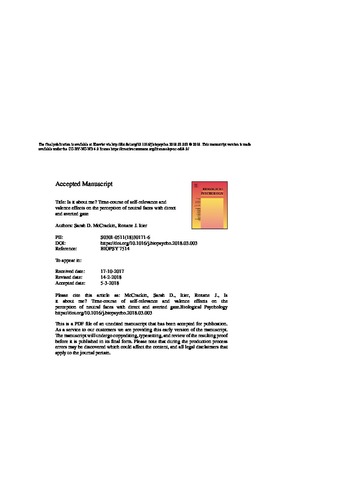| dc.contributor.author | McCrackin, Sarah D. | |
| dc.contributor.author | Itier, Roxane J. | |
| dc.date.accessioned | 2018-04-03 17:08:21 (GMT) | |
| dc.date.available | 2018-04-03 17:08:21 (GMT) | |
| dc.date.issued | 2018-05-01 | |
| dc.identifier.uri | http://dx.doi.org/10.1016/j.biopsycho.2018.03.003 | |
| dc.identifier.uri | http://hdl.handle.net/10012/13072 | |
| dc.description | The final publication is available at Elsevier via http://dx.doi.org/10.1016/j.biopsycho.2018.03.003 © 2018. This manuscript version is made available under the CC-BY-NC-ND 4.0 license https://creativecommons.org/licenses/by-nc-nd/4.0/ | en |
| dc.description.abstract | Most face processing research has investigated how we perceive faces presented by themselves, but we view faces everyday within a rich social context. Recent ERP research has demonstrated that context cues, including self-relevance and valence, impact electrocortical and emotional responses to neutral faces. However, the time-course of these effects is still unclear, and it is unknown whether these effects interact with the face gaze direction, a cue that inherently contains self-referential information and triggers emotional responses. We primed direct and averted gaze neutral faces (gaze manipulation) with contextual sentences that contained positive or negative opinions (valence manipulation) about the participants or someone else (self-relevance manipulation). In each trial, participants rated how positive or negative, and how affectively aroused, the face made them feel. Eye-tracking ensured sentence reading and face fixation while ERPs were recorded to face presentations. Faces put into self-relevant contexts were more arousing than those in other-relevant contexts, and elicited ERP differences from 150 to 750 ms post-face, encompassing EPN and LPP components. Self-relevance interacted with valence at both the behavioural and ERP level starting 150 ms post-face. Finally, faces put into positive, self-referential contexts elicited different N170 ERP amplitudes depending on gaze direction. Behaviourally, direct gaze elicited more positive valence ratings than averted gaze during positive, self-referential contexts. Thus, self-relevance and valence contextual cues impact visual perception of neutral faces and interact with gaze direction during the earliest stages of face processing. The results highlight the importance of studying face processing within contexts mimicking the complexities of real world interactions. | en |
| dc.description.sponsorship | Natural Sciences and Engineering Research Council of Canada (NSERC Discovery Grant #418431) | en |
| dc.description.sponsorship | Ontario government (Early Researcher (Award, ER11-08-172) | en |
| dc.description.sponsorship | Canada Foundation for Innovation (CFI, #213322) | en |
| dc.description.sponsorship | Canada Research Chair (CRC, #213322 and #230407) | en |
| dc.description.sponsorship | Queen Elizabeth II Graduate Scholarship for Science and Technology (QEII-GSST) | en |
| dc.language.iso | en | en |
| dc.publisher | Elsevier | en |
| dc.rights | Attribution-NonCommercial-NoDerivatives 4.0 International | * |
| dc.rights.uri | http://creativecommons.org/licenses/by-nc-nd/4.0/ | * |
| dc.subject | Context | en |
| dc.subject | EPN | en |
| dc.subject | ERP | en |
| dc.subject | Face processing | en |
| dc.subject | Gaze | en |
| dc.subject | LPP | en |
| dc.subject | N170 | en |
| dc.subject | Self-relevance | en |
| dc.subject | Valence | en |
| dc.title | Is it about me? Time-course of self-relevance and valence effects on the perception of neutral faces with direct and averted gaze | en |
| dc.type | Article | en |
| dcterms.bibliographicCitation | McCrackin, S. D., & Itier, R. J. (2018). Is it about me? Time-course of self-relevance and valence effects on the perception of neutral faces with direct and averted gaze. Biological Psychology, 135, 47–64. https://doi.org/10.1016/j.biopsycho.2018.03.003 | en |
| uws.contributor.affiliation1 | Faculty of Arts | en |
| uws.contributor.affiliation2 | Psychology | en |
| uws.typeOfResource | Text | en |
| uws.typeOfResource | Text | en |
| uws.peerReviewStatus | Reviewed | en |


